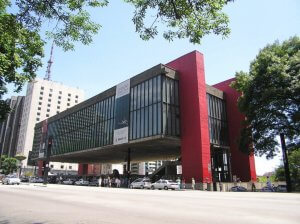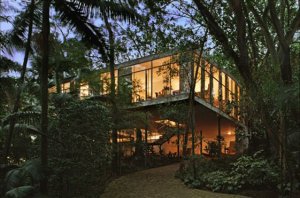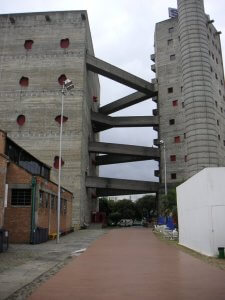Lina Bo Bardi - A Pioneer of Modern Architecture

Lina Bo Bardi is one of the best-known figures of modern architecture, designing some of the most important and expressive examples of 20th Century Brazilian architecture. She studied architecture at the School of Architecture at the University of Rome before moving to Milan.
Some years after her move to Milan, she left Italy on a trip that would change her life forever. Bo Bardi arrived in Brazil in 1946. There, she soon discovered the lively music and bright colors that would make her fall in love with the country. She brought with her many new ideas about modern architecture, inspired by her native country of Italy.
Lina Bo Bardi quickly came to love Brazil as she did her own country. Throughout her career, she contributed greatly to the creation of authentic Brazilian architecture.
A brief look at the life of Lina Bo Bardi

Lina Bo Bardi, born Achillina Bo, studied architecture at La Sapienza University in Rome, before graduating in 1939. For her final project, she designed “The Maternity and Infancy Care Center” – a maternity ward for single mothers.
At the end of World War II, she joined the resistance, and in 1945, she founded the magazine A Cultura della Vita, along with her professor Bruno Zevi, and her colleague Carlo Pagani. Bo Bardi lived in Milan from 1940 to 1945, when she decided to return to Rome. Disappointed with post-war Italy, she traveled to Brazil with her husband Pietro Maria Bardi in 1946.
On arriving in Brazil, they settled in Sao Paulo, and by 1951, Lina became a Brazilian citizen. However, she never lost touch with her family in Rome. She also remained in contact with several Italian architects, particularly Bruno Zevi, and made occasional trips back to Europe to visit them.
By 1950, she had designed and built her own house, La Casa de Vidro (the Glass House). In 1957, she began working on a project to build the São Paulo Museum of Art, which opened in 1968. To this day, her work remains one of the best examples of modern Brazilian architecture. It stands out for its giant porticoed structure and open-plan rooms.
Gaudí had a huge influence on Bo Bardi’s work. This became increasingly evident in her work after a visit to Barcelona in 1957, most notably in the Cirell House (1958), Chame-Chame House (1958) and in the Espírito Santo do Cerrado Church in Uberlândia (1976 – 1982).
In 1959, she received an invitation to work in Salvador de Bahia, spearheading a project to build the new Museum of Modern Art on the site of an old sugar mill.
Lina Bo Bardi’s most notable works

Bo Bardi’s most famous and celebrated work is the SESC leisure and cultural center in the popular Pompeia district in Sao Paulo. The building was created on the site of an abandoned drum factory, between 1977 and 1986.
Bo Bardi wanted to respect the horizontal structure of the pre-existing warehouses and make use of all the available space. Her design features red brick and large concrete towers, linked by aerial walkways.
Another notable project was Chame-Chame House, lead by Bo Bardi in 1964. This house was particularly noteworthy, as it was built around an ancient jackfruit tree.
The site was located on the corner of a fork in the road and sat on a slight slope. A path curves up around one of the corners, leading to a backyard. The building itself was surrounded by a ramp, providing car access. On the opposite was a staircase, leading to the service entrance.
The house was located at the center of the site, away from all the exterior walls and, in turn, away from the street. The rough stone walls were made up of a mixture of straight and curved segments, and embedded with pebbles and plants.
“The purpose of a house is to provide a good and comfortable life. It would be a mistake to place too much value on an exclusively decorative result.”
– Lina Bo Bardi
Other key contributions
This Italian-Brazilian architect didn’t just dedicate her life to architecture – she also dabbled in jewelry and furniture design and even worked on designing exhibitions and theater sets.
One of her last projects was remodeling an office building into the new Sao Paulo theater, the Teatro Oficina (1980 – 1991).
She also made huge contributions to the theory of architecture. Her manuscript, Contribuição Propedeutica ao ensino da Teoria da Arquitetura (Propaedeutic Contribution to the Teaching of the Theory of Architecture, 1957) remains a key text in modern architectural theory. In it, she takes a humanistic approach in defense of a cultured and ecological architecture based on technological advances.
Lina Bo Bardi is one of the best-known figures of modern architecture, designing some of the most important and expressive examples of 20th Century Brazilian architecture. She studied architecture at the School of Architecture at the University of Rome before moving to Milan.
Some years after her move to Milan, she left Italy on a trip that would change her life forever. Bo Bardi arrived in Brazil in 1946. There, she soon discovered the lively music and bright colors that would make her fall in love with the country. She brought with her many new ideas about modern architecture, inspired by her native country of Italy.
Lina Bo Bardi quickly came to love Brazil as she did her own country. Throughout her career, she contributed greatly to the creation of authentic Brazilian architecture.
A brief look at the life of Lina Bo Bardi

Lina Bo Bardi, born Achillina Bo, studied architecture at La Sapienza University in Rome, before graduating in 1939. For her final project, she designed “The Maternity and Infancy Care Center” – a maternity ward for single mothers.
At the end of World War II, she joined the resistance, and in 1945, she founded the magazine A Cultura della Vita, along with her professor Bruno Zevi, and her colleague Carlo Pagani. Bo Bardi lived in Milan from 1940 to 1945, when she decided to return to Rome. Disappointed with post-war Italy, she traveled to Brazil with her husband Pietro Maria Bardi in 1946.
On arriving in Brazil, they settled in Sao Paulo, and by 1951, Lina became a Brazilian citizen. However, she never lost touch with her family in Rome. She also remained in contact with several Italian architects, particularly Bruno Zevi, and made occasional trips back to Europe to visit them.
By 1950, she had designed and built her own house, La Casa de Vidro (the Glass House). In 1957, she began working on a project to build the São Paulo Museum of Art, which opened in 1968. To this day, her work remains one of the best examples of modern Brazilian architecture. It stands out for its giant porticoed structure and open-plan rooms.
Gaudí had a huge influence on Bo Bardi’s work. This became increasingly evident in her work after a visit to Barcelona in 1957, most notably in the Cirell House (1958), Chame-Chame House (1958) and in the Espírito Santo do Cerrado Church in Uberlândia (1976 – 1982).
In 1959, she received an invitation to work in Salvador de Bahia, spearheading a project to build the new Museum of Modern Art on the site of an old sugar mill.
Lina Bo Bardi’s most notable works

Bo Bardi’s most famous and celebrated work is the SESC leisure and cultural center in the popular Pompeia district in Sao Paulo. The building was created on the site of an abandoned drum factory, between 1977 and 1986.
Bo Bardi wanted to respect the horizontal structure of the pre-existing warehouses and make use of all the available space. Her design features red brick and large concrete towers, linked by aerial walkways.
Another notable project was Chame-Chame House, lead by Bo Bardi in 1964. This house was particularly noteworthy, as it was built around an ancient jackfruit tree.
The site was located on the corner of a fork in the road and sat on a slight slope. A path curves up around one of the corners, leading to a backyard. The building itself was surrounded by a ramp, providing car access. On the opposite was a staircase, leading to the service entrance.
The house was located at the center of the site, away from all the exterior walls and, in turn, away from the street. The rough stone walls were made up of a mixture of straight and curved segments, and embedded with pebbles and plants.
“The purpose of a house is to provide a good and comfortable life. It would be a mistake to place too much value on an exclusively decorative result.”
– Lina Bo Bardi
Other key contributions
This Italian-Brazilian architect didn’t just dedicate her life to architecture – she also dabbled in jewelry and furniture design and even worked on designing exhibitions and theater sets.
One of her last projects was remodeling an office building into the new Sao Paulo theater, the Teatro Oficina (1980 – 1991).
She also made huge contributions to the theory of architecture. Her manuscript, Contribuição Propedeutica ao ensino da Teoria da Arquitetura (Propaedeutic Contribution to the Teaching of the Theory of Architecture, 1957) remains a key text in modern architectural theory. In it, she takes a humanistic approach in defense of a cultured and ecological architecture based on technological advances.







